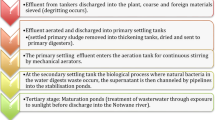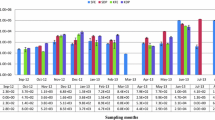Abstract
The objective of this study was to compare sensitivities of enterovirus isolation from wastewater in different cell lines as well as to compare the sensitivity and specificity of isolation in cell culture with direct detection by reverse transcription polymerase chain reaction (RT-PCR). Sixty-eight samples of wastewaters were collected between September 2008 and January 2009 in Yopougon, Abidjan. Enteroviruses were concentrated according to World Health Organization recommendations. Viruses were inoculated into various cell lines while direct RT-PCR was performed on water concentrates. The buffalo green monkey kidney cell line was the most sensitive with 58.8 % of viral isolation. This was followed by the rhabdomyosarcoma cell line with sensitivity of 51.6 %, with human epidermoid carcinoma cell line showing sensitivity of 50 % and fibroblastic cells derived from transgenic mice LTK-1 (L20B) cell showing 23.50 % sensitivity. However, a lower specificity of 2.9 % was observed with the L20B cell line. 44.1 % of the samples were positive by direct RT-PCR detection while 51.47 % samples were positive by using RT-PCR on infected cell cultures. No difference in percentage positivity was observed using RT-PCR on infected tissue culture isolates or using RT-PCR directly on wastewater samples.



Similar content being viewed by others
References
Abbaszadegan, M., Huber, M. S., Gerba, C. P., & Pepper, I. L. (1993). Detection of enteroviruses in groundwater with the polymerase chain reaction. Applied and Environmental Microbiology, 59(5), 1318–1324.
Afssa (2005) Virus transmissibles a l’homme par voie orale. Comment interpréter la présence du génome viral dans les matrices alimentaires et en milieu hydrique en terme d’infectiosité potentielle. Doc. p. 62.
Bessaud, M., Jegouic, S., Joffret, M. L., Barge, C., Balanant, J., Gouandjika-Vasilache, I., et al. (2008). Characterization of the genome of human enteroviruses: Design of generic primers for amplification and sequencing of different regions of the viral genome. Journal of Virological Methods, 149(2), 277–284.
CDC. (2008). Progress toward interruption of wild poliovirus transmission-worldwide, January 2007–April 2008. Morbidity and Mortality Weekly Report, 57, 489–494.
CDC. (2012). Assessments of risks to the global polio eradication initiative (GPEI) strategic plan 2010–2012, Doc CDC, p. 20.
Clarke, L. (2007). Viruses, rickettsiae, chlamydiae, and mycoplasmas. Essential procedures for clinical microbiology (pp. 533–550). Washington DC: ASM.
Grabow, W. O. K., Botma, K. L., De Villiers, J. C., Clay, C. G., & Erasmus, B. (1999). Assessment of cell culture and polymerase chain reaction procedures for the detection of polioviruses in wastewater. Bulletin of the World Health Organization, 77(12), 973–980.
Greening, G. E., Hewitt, J., & Lewis, G. D. (2002). Evaluation of integrated cell culture-PCR (C-PCR) for virological analysis of environmental samples. Journal of Applied Microbiology, 93(5), 745–750.
Hassine, M., Sdiri, K., Riabi, S., Beji, A., Aouni, Z., & Aouni, M. (2010). Detection of enteric viruses in wastewater of Monastir region by RT-PCR method. La Tunisie Médicale, 88(2), 70.
Hovi, T., & Stenvik, M. (1994). Selective isolation of poliovirus in recombinant murine cell line expressing the human poliovirus receptor gene. Journal of Clinical Microbiology, 32(5), 1366–1368.
Lee, C., Lee, S. H., Han, E., & Kim, S. J. (2004). Use of cell culture-PCR assay based on combination of A549 and BGMK cell lines and molecular identification as a tool to monitor infectious adenoviruses and enteroviruses in river water. Applied and Environmental Microbiology, 70(11), 6695–6705.
Leland, D. S., & Ginocchio, C. C. (2007). Role of cell culture for virus detection in the age of technology. Clinical Microbiology Reviews, 20(1), 49–78.
Lipson, S. M., Poshni, I. A., Ashley, R. L., Grady, L. J., Ciamician, Z., & Teichberg, S. (1993). Presumptive identification of common adenovirus serotypes by the development of differential cytopathic effects in the human lung carcinoma (A549) cell culture. FEMS Microbiology Letters, 113(2), 175–182.
Ma, J. F., Gerba, C. P., & Pepper, I. L. (1995). Increased sensitivity of poliovirus detection in tap water concentrates by reverse transcriptase-polymerase chain reaction. Journal of Virological Methods, 55(3), 295–302.
Mendelsohn, C. L., Wimmer, E., & Racaniello, V. R. (1989). Cellular receptor for poliovirus: Molecular cloning, nucleotide sequence, and expression of a new member of the immunoglobulin superfamily. Cell, 56(5), 855–865.
Momou, K. J., Akoua-Koffi, C., Akré, D. S., Adjogoua, E. V., Tiéoulou, L., & Dosso, M. (2012). Detection of enteroviruses in urban wastewater in Yopougon, Abidjan. Pathologie-biologie, 60(3), e21–e26.
Muscillo, M., Carducci, A., La Rosa, G., Cantiani, L., & Marianelli, C. (1997). Enteric virus detection in Adriatic seawater by cell culture, polymerase chain reaction and polyacrylamide gel electrophoresis. Water Research, 31(8), 1980–1984.
Nadkarni, S. S., & Deshpande, J. M. (2003). Recombinant murine L20B cell line supports multiplication of group A coxsackieviruses. Journal of Medical Virology, 70(1), 81–85.
Pipkin, P. A., Wood, D. J., Racaniello, V. R., & Minor, P. D. (1993). Characterisation of L cells expressing the human poliovirus receptor for the specific detection of polioviruses in vitro. Journal of Virological Methods, 41(3), 333–340.
Rajtar, B., Majek, M., Polanski, L., & Polz-Dacewicz, M. (2008). Enteroviruses in water environment—A potential threat to public health. Annals of Agricultural and Environmental Medicine, 15(2), 199–203.
Rashmi, C., Alka, S., Tapas, D., & Dhole, T. N. (2005). Rapid detection of sewage sample polioviruses by integrated cell culture polymerase chain reaction. Archives of Environmental and Occupational Health, 158(8), 807–815.
Reynolds, K. S., Gerba, C. P., & Pepper, I. L. (1997). Rapid PCR-based monitoring of infectious enteroviruses in drinking water. Water Science and Technology, 35(11), 423–427.
Rodríguez, R. A., Gundy, P. M., & Gerba, C. P. (2008). Comparison of BGM and PLC/PRC/5 cell lines for total culturable viral assay of treated sewage. Applied and Environmental Microbiology, 74(9), 2583–2587.
Saeed, M., Zaidi, S. Z., Naeem, A., Masroor, M., Sharif, S., Shaukat, S., et al. (2007). Epidemiology and clinical findings associated with enteroviral acute flaccid paralysis in Pakistan. BMC Infectious Diseases, 7(1), 6.
Shieh, Y. S., Baric, R. S., & Sobsey, M. D. (1997). Detection of low levels of enteric viruses in metropolitan and airplane sewage. Applied and Environmental Microbiology, 63(11), 4401–4407.
WHO. (2003). Guidelines for environmental surveillance of poliovirus circulation WHO/V&B/03.03 ORIGINAL.ENGLISH Vaccines and Biologicals World Health Organization.
WHO. (2004). Polio laboratory manuel under revision. Available on the internet at http://www.who.int/vaccines/en/poliolab/PolioManuel%20version_1May01.pdf.
WHO. (2010). Flambées consécutives à l’importation du poliovirus sauvage dans les régions africaine, européenne et d’Asie du sud-est de l’OMS REH, 85, 445–452.
Zoll, G. J., Melchers, W. J., Kopecka, H., Jambroes, G., Van der Poel, H. J., & Galama, J. M. (1992). General primer-mediated polymerase chain reaction for detection of enteroviruses: Application for diagnostic routine and persistent infections. Journal of Clinical Microbiology, 30(1), 160–165.
Zurbriggen, S., Tobler, K., Abril, C., Diedrich, S., Ackermann, M., Pallansch, M. A., et al. (2008). Isolation of sabin-like polioviruses from wastewater in a country using inactivated polio vaccine. Applied and Environmental Microbiology, 74(18), 5608–5614.
Acknowledgments
We thank Professor Adu Festus Virologist, Chairman GrassRoot Immunizations and Wellness Promotion Initiatives (GRIMWELL Promo) Ibadan (Nigeria), for critically reading the manuscript. We are also indebted to Tieoulou Leontine of Epidemic viruses Department, Pasteur Institute (Cote d’Ivoire). National Institute For communicable Diseases of Johannesbourg (South Africa) for providing RD and L20B cell lines. Pasteur Institute-Paris (France), for generous gift of HEP-2c and BGM cell lines.
Author information
Authors and Affiliations
Corresponding author
Rights and permissions
About this article
Cite this article
Momou, K.J., Akoua-Koffi, C. & Dosso, M. Detection of Enteroviruses in Water Samples from Yopougon, Côte d’Ivoire by Cell Culture and Polymerase Chain Reaction. Food Environ Virol 6, 23–30 (2014). https://doi.org/10.1007/s12560-013-9130-4
Received:
Accepted:
Published:
Issue Date:
DOI: https://doi.org/10.1007/s12560-013-9130-4




